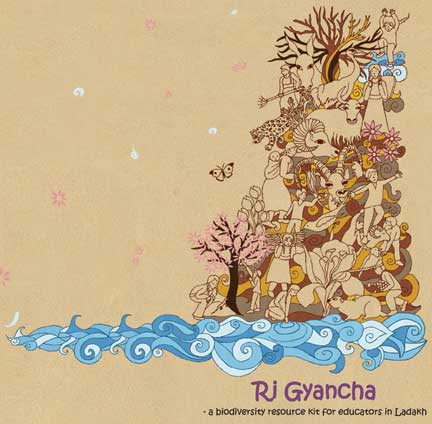Geetha Iyer
‘Ri Gyancha, a biodiversity resource kit for educators in Ladakh’ is a very useful resource for teachers. Such materials help in ensuring that conservation-education becomes contextually relevant and resultant learning meaningful. These are times when books are generally given a wide berth by many. But this colourfully produced book with photographs that are a visual treat should attract the attention of teachers and students alike.
The language is simple, ensuring that even for those who are not entirely comfortable with the English language, this book will not be difficult to use. Use of local names along with English ones is a good idea. Perhaps (at least in the posters) these names could have been written in the script commonly used in Ladakh.
 A wide variety of activities, ready-to-use materials and posters have been carefully connected so that they are coherent and valuable both for teachers and non-teaching resource people involved in this field. It is quite evident that a lot of hard work has gone into developing these materials. Activities have been closely linked to the information on local fauna and flora, offering a pragmatic approach. Attempt has been made to ensure that these activities go beyond mere information gathering.
A wide variety of activities, ready-to-use materials and posters have been carefully connected so that they are coherent and valuable both for teachers and non-teaching resource people involved in this field. It is quite evident that a lot of hard work has gone into developing these materials. Activities have been closely linked to the information on local fauna and flora, offering a pragmatic approach. Attempt has been made to ensure that these activities go beyond mere information gathering.
However, these points could be considered if this book is reprinted.
Like most resource books produced in this field, this one also ignores ocean diversity. Beyond a brief mention, nothing about ocean or aquatic ecosystems figures meaningfully. This is a crucial lapse; even if children live in a mountainous region, it is essential to know the vital link between the mountain, the river, and the ocean. Climate change and global warming cannot make sense when this link is not available. Conservation education must be complete and it is therefore sad that while listing varieties of animal diversity fishes, prawns, molluscs, etc., have been left out. Rivers and streams in Ladakh would surely support aquatic living organisms! A missed opportunity.
Most activities are suggested as ‘indoor’. Of the 80 activities given, only 10+ have suggestions for exclusive outdoor work; even here with the exception of two or three most are games or storytelling activities. It would be interesting to know why activities that involve observations or about habitats have not been tried outdoors.
 Specifying the age group/level at which these activities can be conducted would help educators using this document. Since the activities range from extremely simple to complex, class/difficulty level could have been added to the extensive assistance provided under each activity.
Specifying the age group/level at which these activities can be conducted would help educators using this document. Since the activities range from extremely simple to complex, class/difficulty level could have been added to the extensive assistance provided under each activity.
Finally, from experience I know that pencil diagrams are best presented without shading as has been shown for insects. The insect diagrams lack in accuracy and will not help students study these animals correctly. Moreover, we live in an era where digital photography is the order of the day. Students with the ability to create pencil diagrams are an endangered group. Insect diagrams of this kind will not help those who may have the inclination for drawing. Diagrams similar to the ones given for Blue Sheep/chukar grids would be far more useful. Why is a part of the grasshopper’s leg missing? As far as possible this kind of compromise – accuracy for creativity – is best avoided in books that serve to educate.
Despite these lapses, Ri Gyancha is an appreciable effort. Working in the remote mountains and trying out the materials would have been quite a difficult task. The authors and the institutions need to be congratulated for the work done. A nice gift for the Ladakhi children.
The reviewer is consultant for science and environmental education. She can be reached at scopsowl@gmail. com.
Price Rs. 350/-, postage extra
For ordering copies of the book, contact:
kvbooks@gmail.com
Phone: 020-25654239/25675450
